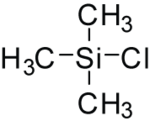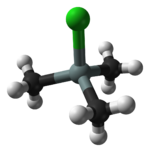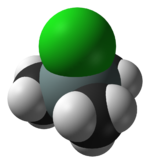- Trimethylsilyl chloride
-
Trimethylsilyl chloride 

 Trimethylsilyl chlorideOther namesChlorotrimethylsilane
Trimethylsilyl chlorideOther namesChlorotrimethylsilane
TMSCl
Trimethylchlorosilane
TMCSIdentifiers CAS number 75-77-4 
PubChem 6397 ChemSpider 6157 
RTECS number VV2710000 Jmol-3D images Image 1 - C[Si](C)(C)Cl
Properties Molecular formula C3H9SiCl Molar mass 108.64 g/mol Appearance Colorless liquid, fumes in moist air Density 0.856 g/cm3, liquid Melting point −40 °C (233.2 K)
Boiling point 57 °C (330.2 K)
Solubility in water reacts Structure Molecular shape tetrahedral at Si Hazards EU classification Flammable (F)
Corrosive (C)R-phrases R11, R14, R20, R21, R35, R37 S-phrases S16, S26, S36, S37, S39, S45 NFPA 704 Flash point −28 °C Autoignition
temperature400 °C Related compounds Related halosilanes Trimethylsilyl fluoride
Trimethylsilyl bromide
Trimethylsilyl iodide chloride (verify) (what is:
chloride (verify) (what is:  /
/ ?)
?)
Except where noted otherwise, data are given for materials in their standard state (at 25 °C, 100 kPa)Infobox references Trimethylsilyl chloride, also known as chlorotrimethylsilane is a silyl halide, with a variety of different uses in chemistry. It has the formula (CH3)3SiCl, and under standard conditions it is a colourless liquid, which is stable in the absence of water. It can be prepared from silicon tetrachloride by nucleophillic substitution of three of the chloride groups with a nucleophillic methyl source such as methyllithium, however the compound is readily available commercially.
Uses
Trimethylsilyl chloride has variety of uses in chemistry, both as a source of the trimethylsilyl group, and as an anhydrous source of chlorides. Functional groups such as alcohols and amines readily undergo reaction with trimethylsilyl chloride, giving trimethylsilyl ethers and trimethylsilyl amines. These new groups can be used as protecting groups for the original functional group, however the lability of the trimethylsilyl group restricts their utility. Trimethylsilylation can also be used to increase the volatility of a compound, enabling gas chromatography of normally non-volatile substances such as glucose. Trimethylsilyl chloride also reacts with metal acetylides to give trimethylsilyl alkynes, which are useful protected forms of alkynes.
The reaction of trimethylsilyl chloride with alcohols gives rise to an equivalent of hydrogen chloride. This reaction can be exploited to create anhydrous solutions of hydrochloric acid in alcohols, which find use in the mild synthesis of esters and acetals from carboxylic acids and ketones respectively.
In the presence of triethylamine and lithium diisopropylamide, enolisable aldehydes, ketones and esters are converted to trimethylsilyl enol ethers. Despite their hydrolytic instability, these compounds have found wide application in organic chemistry; oxidation of the double bond by epoxidation or dihydroxylation can be used to return the original carbonyl group with an alcohol group at the alpha carbon. The trimethylsilyl enol ethers can also be used as masked enolate equivalents in the Mukaiyama aldol addition.
Trimethylsilyl chloride can also be used as a starting material to prepare other trimethylsilyl halides and pseudohalides, such as:
- Trimethylsilyl fluoride
- Trimethylsilyl bromide
- Trimethylsilyl iodide
- Trimethylsilyl cyanide
- Trimethylsilyl azide[1]
- Trimethylsilyl trifluoromethanesulfonate (TMSOTf)
These compounds are produced by an exchange reaction between trimethylsilyl chloride and a salt of the (pseudo)halide (MX):
- MX + Me3Si-Cl → MCl + Me3Si-X
Trimethylsilyl chloride is also used to silanize laboratory glassware, making the surfaces more lipophilic.[2]
References
- ^ L. Birkofer and P. Wegner (1988), "Trimethylsilyl azide", Org. Synth., http://www.orgsyn.org/orgsyn/orgsyn/prepContent.asp?prep=cv6p1030; Coll. Vol. 6: 1030
- ^ Such as in Norbert Zander and Ronald Frank (2005), "The use of polystyrylsulfonyl chloride resin as a solid supported condensation reagent for the formation of esters: Synthesis of N-[(9-fluorenylmethoxy)carbonyl]-L-aspartic acid; α tert-butyl ester, β-(2-ethyl[(1E)-(4-nitrophenyl)azo]phenyl]amino]ethyl ester", Org. Synth. 81: 235, http://www.orgsyn.org/orgsyn/orgsyn/prepContent.asp?prep=v81p0235
Categories:- Reagents for organic chemistry
- Silanes
Wikimedia Foundation. 2010.

